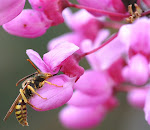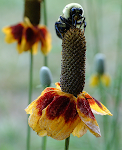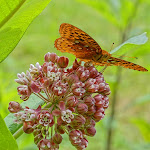Thursday, June 17, 2010
Home Made Tonic for Healthy Bees
I made it last year and was really pleased at the results - the bees definitely get excited by the aroma. In fact, while I was making it they pressed in droves against my open kitchen window screens - so when it says it "not be left open around bees" take it seriously!
Here it is:
5 cups water
2 ½ pounds of sugar
1/8 teaspoon lecithin granules (used as an emulsifier)
15 drops spearmint oil
15 drops lemongrass oil
Bring the water to a boil and integrate the sugar until dissolved. Once the sugar is dissolved remove the mixture from the heat and quickly add the lecithin and the essential oils. Stir until everything is evenly distributed. This solution should have a strong scent and not be left open around bees. Cool before using.
Cool side benefit - put it in a spray bottle and spritz it instead of using smoke to calm the bees! I have worked my hives just using this and everyone was fat and happy.
Thursday, May 13, 2010
Queenless and Queenright
Drama in the hives. Last post I was worrying about foulbrood. I had settled on the strategy (learned in the book "Natural Beekeeping") of housing the queen and her workers in an entirely new, clean hive and burning the old one.
Confirmed in this plan by my mentors, I set upon this daunting task. It involved: finding the queen and picking her up (that part gave me the willies), putting her in the new box, then brushing all bees off each frame into the new hive. Lots of upset bees. Then hide all the brood and honey frames from the bees so they don't take the contagion with them, feed them sugar water, and scorch out the old boxes, etc.
I was rather depressed afterward. Even more depressed when I checked in the next day and the queen was gone!! Anguish! And only a handful of workers left.
Well good thing the hive next door (the blue hive, erstwhile Elizabeth) was fixing to swarm. Scads of workers, brood, too many drone cells, honey and - wait for it - about 10 swarm cells. Bad beekeeper! {Note to self - do NOT travel in March/April because the bees will get ahead of you!}. Elizabeth was busting out of the hive.
So I split the hive! I had to read the "unusual situations and advanced techniques" sections of all my books! I felt quite the hive rock star.
I put all the frames with swarm cells into their own new fresh box, gave them honey frames, and tried to find the old queen to leave her in the old box with lots of new brood and honey space.
Except that I couldn't find her.
There are squillions of bees in a full hive. And they are all moving around so much. And they rarely make that convenient circle around the queen all pointing at her like they do in the pictures. And she hadn't been marked {note to self: mark the dang queens}.
I shut the hives after exhaustive searching (with no veil and with magnifying glasses on; hello - bees in my hair). And prayed Elizabeth had not just got shut up in the tight new hive with all those restive swarm cells...
Upshot is: the bee goddess smiled on me. I checked in and the new hive still had swarm cells and the bees were tense when I opened them up. High pitched whining, frantic motion, many more guards buzzing my face - I had the distinct impression they were upset and wanted the top put on NOW. So I did.
Then I checked Elizabeth's hive and what a difference: calm, quiet, mellow bees. Happily socking away honey (a whole box in one week!). Happy making brood, no swarms cells. Amazing what a different feeling a queenless hive gives compared to a queenright hive. I was moved by the experience. So I am waiting on the new queen to hatch!
Last thing - turns out the other hive did not have foulbrood. Something was way wrong with the brood - our state apiarist happened to be at our beekeepers club meeting last week but he said, no, not foulbood. But he took one of my brood frames to be analyzed in the lab.
Monday, April 19, 2010
The joy and the pain of beekeeping
The answer is mixed: one hive, the blue one, is doing splendidly. Lots of honey from last season, lots of brood, lots of workers. I had checked in three weeks ago, before leaving on a big trip, and came home intending to reverse all the hive boxes (swapping bottom with top boxes keeps a production chain going by putting the empty frames back on top for Queen Elizabeth to fill). This I did.
My only concern about Elizabeth was she has more than the usual number of drone cells. Not so many that I think workers are laying (i.e. no queen present), but more than the usual distribution. I seem to remember that last year, prior to swarming, there were a lot of drone cells. Maybe Eliz was feeling crowded and the wheels are now in motion. This time around I'd like to split her hive if it comes to it, capturing bees before they leave. Also I might need to because I fear I am losing my second hive...
The green hive, Kathryn's, I was worried about last fall. She had a heavy varroa mite infestation and I'd seen crippled wing disease. Her worker numbers were WAY down after the winter. Three weeks ago I had given her a frame of Elizabeth's brood, hoping to boost numbers.
However, when I opened her up yesterday I saw: very small amount of brood, a spotty brood pattern, holes in some of the brood caps, and dead rotting larvae inside cells. All of this sounds like Foulbrood, a perfectly horrible disease that not only kills off the hive, but requires the keeper to burn everything because the disease is spread by spores which contaminate the hive boxes and frames.
See what I mean about the pain of beekeeping? I've put a call out to my beekeeping mentors to confirm the diagnosis.
*Sigh*. Such a bummer.
Friday, October 30, 2009
Happy Halloween
Bee safe out there ya'll.
Wednesday, October 28, 2009
Air circulation and feeding in winter
from http://basicbeekeeping.blogspot.com/
LESSON 66: Screen Bottom Boards In The Winter & Fall & Winter Feeding
In a previous lesson, I shared several approaches on how to prepare for winter. In this lesson I want to go into more detail about screen bottom boards and winter feeding.
 Screen bottom boards prove to be very beneficial in the summer for reducing mites and for increasing ventilation. But do they pose a threat to a colony during the winter? That's a debated issue. Some cover their screen bottom boards while others leave them open. A few years ago, we did a simple test. We placed covers over 3 colony's screen bottom board and left the others open. We lost all three that were covered. So we always leave our screen bottom boards open all winter. It is our opinion that an open screen bottom board cuts down on excessive moisture. Cold air sinks and warm air rises, so the threat of an open screen bottom board, in our opinion, is minimal.
Screen bottom boards prove to be very beneficial in the summer for reducing mites and for increasing ventilation. But do they pose a threat to a colony during the winter? That's a debated issue. Some cover their screen bottom boards while others leave them open. A few years ago, we did a simple test. We placed covers over 3 colony's screen bottom board and left the others open. We lost all three that were covered. So we always leave our screen bottom boards open all winter. It is our opinion that an open screen bottom board cuts down on excessive moisture. Cold air sinks and warm air rises, so the threat of an open screen bottom board, in our opinion, is minimal.If your hive is up in the air 6 or 8 inches, then you want to prevent cold wind from curling up and blowing onto the cluster. This can be accomplished by building a wind block around your hive.
Remember, that a winter cluster warms only the cluster and not the inside of the hive. On an extremely cold night, the air several inches away from the cluster will be the same as outside the hive. The bees consume honey, and vibrate by flexing their muscles to generate heat, much like we do when we shiver. That heat is transferred throughout the cluster. They will be able to accomplish generating the cluster heat with or without the screen covered.
WHAT ABOUT WINTER FEEDING?
Many beekeepers allow their colonies to become extremely undernourished. Pollen and stored honey is essential to winter survival of colonies. In the fall, I work to beef up my colonies. It's tricky for me because of the number of colonies in one location. Even an inside top feeder can create a robbing frenzy. In the fall, boardman feeders placed in the front of hives is a certain robbing disaster.
So my approach is two fold. 1) During the fall only, after most nectar is no longer available, I want to prevent robbing, and 2) I want to beef up my colony nutrition for winter.

You can click on the images for a larger view. My approach is simple. I do use boardman feeders, but I place them on stands throughout the bee yard. And on dry days, I pour dry pollen out on the feed stands. My sugar mix is two parts sugar and one part water for fall. I have to make the holes bigger in the lids for the syrup to pass through. I also add one teaspoon of Honey-B-Healthy. Also, notice the bees on top of the jars? I make sugar patties too.
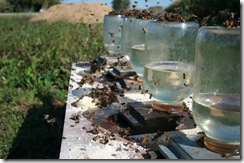 I mix sugar syrup with powdered sugar until it mixes a little stiffer than play dough. The bees love these sugar patties. I placed one on the top of each jar as you can see in the picture.
I mix sugar syrup with powdered sugar until it mixes a little stiffer than play dough. The bees love these sugar patties. I placed one on the top of each jar as you can see in the picture.So my fall feeding consist of dry pollen, hard sugar patties and 2:1 sugar syrup. Several people have asked me what 2:1 sugar means in measurements. I fill a gallon jar with between 32-48 ounces of very hot water. Then, I add sugar until it reaches the top which is around 7-8 pounds. Then stir it up. I will continue this type of feeding until the bees are clustered for winter.
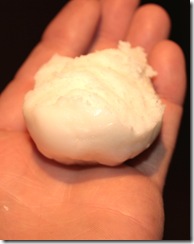 Another very effective winter feeding method is to make the sugar patties I mentioned above and lay on the tops of frames just above the cluster. Because it is a solid sugar feed, you do not have to worry about it freezing. The heat of the cluster will keep it warm and eatable.
Another very effective winter feeding method is to make the sugar patties I mentioned above and lay on the tops of frames just above the cluster. Because it is a solid sugar feed, you do not have to worry about it freezing. The heat of the cluster will keep it warm and eatable.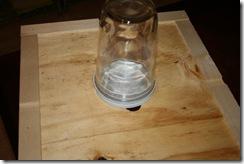 As the weather warms up above freezing, you can place pale feeders in the hive. I sometimes place jars of sugar water over the inner cover hole and then place a deep hive body without the frames so that the bees can consume the sugar water when it warms enough for the bees to break cluster. The deep hive body serves as a spacer around the jar. The top cover goes above the deep hive body spacer.
As the weather warms up above freezing, you can place pale feeders in the hive. I sometimes place jars of sugar water over the inner cover hole and then place a deep hive body without the frames so that the bees can consume the sugar water when it warms enough for the bees to break cluster. The deep hive body serves as a spacer around the jar. The top cover goes above the deep hive body spacer. Another important feed application is that of internal pollen patties. If pollen sources are low within a colony, brood patties should be placed above the cluster. Again, on warmer winter days, the cluster will loosen enough so that bees can feed upon the pollen patties which contain a pollen substitute allowing the bees to consume the protein, vitamins, lipids and amino acids they need. ALWAYS leave the wax paper on the patty. The bees will eat around it, and usually they consume the paper too. If you remove the wax paper, the patty can become moldy and too gooey and fall between the frames.
Another important feed application is that of internal pollen patties. If pollen sources are low within a colony, brood patties should be placed above the cluster. Again, on warmer winter days, the cluster will loosen enough so that bees can feed upon the pollen patties which contain a pollen substitute allowing the bees to consume the protein, vitamins, lipids and amino acids they need. ALWAYS leave the wax paper on the patty. The bees will eat around it, and usually they consume the paper too. If you remove the wax paper, the patty can become moldy and too gooey and fall between the frames.We do sell the sugar patties, pollen patties as well as the screen bottom boards. Give us a call if you need these items or other beekeeping items.
 As we head for the end of the year, I do want to remind everyone that each year we raise our prices on January 1. We are currently offering our complete hive, which consists of a screen bottom board, two deep hive bodies with frames and foundation, one medium super with frames and foundation, an inner cover and a telescoping top cover with aluminum for $179. $170 if you purchase more than one. This price is only good through December 31, 2009. Feel free to order your hives for the spring by calling us at 217-427-2678. We take credit cards over the phone, or you can order online by clicking here.
As we head for the end of the year, I do want to remind everyone that each year we raise our prices on January 1. We are currently offering our complete hive, which consists of a screen bottom board, two deep hive bodies with frames and foundation, one medium super with frames and foundation, an inner cover and a telescoping top cover with aluminum for $179. $170 if you purchase more than one. This price is only good through December 31, 2009. Feel free to order your hives for the spring by calling us at 217-427-2678. We take credit cards over the phone, or you can order online by clicking here.We always appreciate your business, whether it is for your woodenware hive needs, queens, packages, nucs, clothing or extraction equipment, we always appreciate your loyalty.
Here's how you can contact us:
Phone: 217-427-2678
Email: david@honeybeesonline.com
Web Address: www.honeybeesonline.com
Corn Syrup linked to bee colony collapse
Government researchers have found that high-fructose corn syrup, which is used as a sweetening agent in thousands of products, creates potentially dangerous levels of a toxic substance when heated.
The scientists – from USDA’s Agricultural Research Service in Tuscon and New Orleans and at the University of Wisconsin – were searching for a possible cause of Colony Collapse Disorder, a mysterious disease that has killed at least one-third of the nation’s commercial bees.
The team targeted the popular sweetener because it is widely used both with honey bees and those used primarily for vital crop pollination.
High-fructose corn syrup is produced by grinding corn to produce corn starch, then that powder is processed to yield corn syrup, which is almost entirely glucose. Enzymes or proteins are then added which changes the glucose into fructose.
It is the fructose that food producers use to sweeten their products and by commercial beekeepers to strengthen their bees, to increase honey production and as a food supplement when natural sources of nectar and pollen have diminished.
During repeated tests, the researchers found that when the HFCS is heated it forms hydroxymethylfurfural or HMF which can kill honeybees. Alarmingly, they found when temperatures rose, levels of HMF increased steadily in proportion.
The study, by Blaise LeBlanc, Gillian Eggleston and their colleagues, is published this week in ACS’ Journal of Agricultural and Food Chemistry. The authors said their work could also help keep the substance out of soft drinks and dozens of other human foods that contain HFCS.
“The data are important for commercial beekeepers . . . and because HFCS is incorporated as a sweetener in many processed foods, the data from this study are important for human health as well,” states the report which was funded by the National Honey Board.
Laboratory studies in Sweden published this year have linked HMF to DNA damage in humans, the USDA team reported. In addition, HMF breaks down in the body to other substances – daughter metabolites – potentially more harmful than the original substance.
For close to a decade, researchers throughout the world have been searching for the cause of the widespread destruction of bee colonies.
In the U.S., the growing shortage of honey has caused the increased importation of foreign products, much of which is wrongly labeled to avoid paying tariffs on Chinese honey. Some are adulterated with illegal antibiotics on violation of FDA regulations.
Here is a link to the study published by the ACS.



